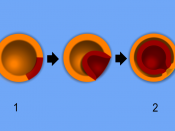November 16, 1995
Hundreds of thousands of times a year a single-celled zygote, smaller than a grain of sand, transforms into an amazingly complex network of cells, a newborn infant. Through cellular differentiation and growth, this process is completed with precision time and time again, but very rarely a mistake in the 'blueprint' of growth and development does occur. Following is a description of how the pathways of this intricate web are followed and the mistakes which happen when they are not.
The impressive process of differentiation changes a single-cell into a complicated system of cells as distinct as bold and bone. Although embryonic development takes approximately nine months, the greatest amount of cellular differentiation takes place during the first eight weeks of pregnancy. This period is called embryogenesis.
During the first week after fertilization, which takes place in the Fallopian tube, the embryo starts to cleave once every twenty-four hours (Fig.
1). Until the eight or sixteen cell stage, the individual cells, or blastomeres, are thought to have the potential to form any part of the fetus (Leese, Conaghan, Martin, and Hardy, April 1993). As the blastomeres continue to divide, a solid ball of cells develops to form the morula (Fig. 1). The accumulation of fluid inside the morula, transforms it into a hollow sphere called a blastula, which implants itself into the inner lining of the uterus, the endometrium (Fig. 1). The inner mass of the blastula will produce the embryo, while the outer layer of cells will form the trophoblast, which eventually will provide nourishment to the ovum (Pritchard, MacDonald, and Gant, 1985).
Figure 1:Implantation process and development during
embryogenesis (Pritchard, MacDonald and
Gant, 1985)
During the second week of development, gastrulation, the process by which the germ layers are formed, begins to occur. The inner cell...
![MacDonald Tartans [8]](https://s.writework.com/uploads/12/129102/macdonald-tartans-8-thumb.jpg)

